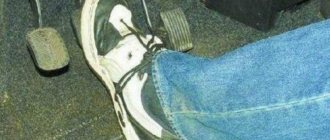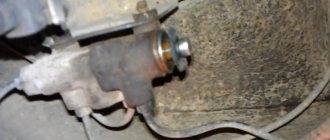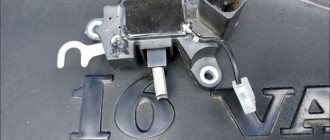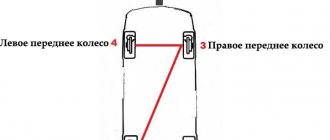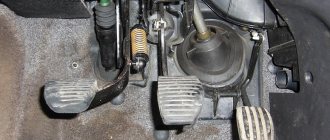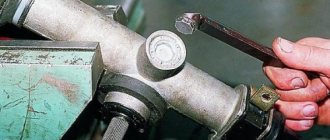It is necessary to bleed the hydraulic brake system circuit after any depressurization caused by repair or replacement of brake cylinders, hoses, tubes, force regulator (sorcerer) or GTZ. Bleeding may also be required after the brakes overheat and fluid boils in the cylinders. Bleed the brake circuit to remove air pockets.
If you trust the experts to bleed the brakes of a VAZ 2110, the price they will charge you will be about 1,000 rubles.
It only includes pumping, and if you do the repair/replacement of the damaged unit directly at a service station, you will have to pay many times more. So, when performing such work yourself, you definitely need to know the pumping procedure, the scheme and what needs to be done in a particular case.
What to prepare for bleeding the brakes of a VAZ 2110/2111/2112
Bleeding VAZ 2110/2111/2112 brakes begins with preparing tools and materials. So, you will need:
- jack;
- a 17mm wheel wrench or a powerful wrench with such a head for removing wheels;
- wrench for 8 or 10 (depending on the type of fittings installed);
- a flat-head screwdriver or a thin mounting blade (when working on a lift);
- a thin transparent hose (for example, from a medical dropper), it is exactly equal to the diameter of the fitting;
- container for expressing liquid;
- bottle of DOT-4 brake fluid.
This set is usually enough to bleed the brakes of a VAZ 2110, the injector is 16 valves or 8, the year of manufacture of the car does not matter. Only the bleeder fittings can differ, which come with an 8 or 10 wrench. It is not advisable to use an open-end wrench to unscrew them, as it licks the edges. It is better to take a special clamping wrench with a screw, and if it is not available, a socket wrench, or a deep 8 or 10 socket with a knob.
Before bleeding the brakes on a VAZ 2110, it is advisable to buy 1-2 liters of new brake fluid; it is not recommended to use an old one or mix two fluids.
Procedure for pumping brakes on a VAZ 2110: work plan
To properly bleed the brakes on a VAZ 2110, the car must be placed on a solid and level surface. If you don’t do this, you won’t be able to accurately monitor the liquid level in the tank and you can avoid airing the system when pumping it yourself when it’s inconvenient for one to control the level in the tank.
The order of bleeding the VAZ 2110 brakes is determined by the location of the circuits. First one swings, then the other. For front-wheel drive VAZs without ABS, the pumping scheme is standard - you need to start from the farthest point.
Sequence of pumping brakes VAZ 2110
Scheme for pumping brakes on a VAZ 2110
On VAZ-2110, 2111, 2112 the circuits are connected diagonally (right front - left rear, and vice versa). Therefore, the procedure for bleeding the VAZ 2110 brakes will be as follows:
- Rear right wheel.
- Front left wheel.
- Rear left wheel.
- Front right wheel.
In order to pump the rear brakes of a VAZ 2110 using a lift according to all the rules, before carrying out the procedure you need to fix the brake force regulator (sorcerer). It is located near the left rear wheel. The sorcerer is locked by installing a flat screwdriver or thin mounting blade between its piston rod and the thrust plate. If you are doing it in a pit, then you don’t need to do this!
You only need to block the sorcerer if the rear axle is hanging in the air. In this position, the beam stops putting pressure on the regulator. As a result, a situation with over-braking of the rear is simulated; if the sorcerer is not supported, the brake lines of the rear wheels are blocked to unlock them. If they do not hang and the beam presses on the sorcerer, it is open, the rear brakes then pump normally.
System malfunctions
There are quite a lot of elements in the system, so it can be very difficult to determine the malfunction. The main malfunctions and their symptoms are described below:
- Braking is too slow.
A common problem that can be caused by grease or brake fluid getting into the friction area of the brakes. Also, a decrease in efficiency occurs due to wear or damage to the pads (only replacement will help). If the adjustment is made incorrectly, the system will overheat, and as a result, braking efficiency will noticeably decrease. Dismantling the amplifier - Increasing pedal stroke. Usually, with such a defect, the braking force decreases significantly, but sometimes it remains at the same level. The most common reason is a leak. First of all, you need to inspect the drums and calipers. If a damaged part is found through which the liquid escapes, it must be replaced. Air in the system hydraulic line can also cause an increase in stroke - to eliminate the problem, the brakes need to be properly bled (the process is described in detail below).
- After braking is completed, the “ten” wheels are partially released. The cause of the defect may be a violation of the protrusion of the adjusting nut on the vacuum booster rod. This malfunction can also be caused by jamming of one of the parts of the brake mechanism.
Bleeding the brakes of a VAZ 2110: order with the sorcerer
VAZ 2110 – bleeding the brakes, the video is shown using Kalina as an example, but the system is the same type. The fact that there is no sorcerer here does not bother you either; on cars equipped with an ABS system, its function is performed by electronics
Correct bleeding of the VAZ 2110 brakes is carried out with an assistant in this order:
- Open the hood, disconnect the fuel level sensor chip.
- Remove the plug from the GTZ reservoir and add fluid to the maximum.
- Lock the brake force regulator (sorcerer) if work is carried out on a lift.
- Remove the wheel whose brakes will be pumped if work is carried out without a lift or pit.
- Remove the rubber cap from the brake cylinder bleeder fitting and place a transparent tube on it.
- Place a container to collect excess liquid, pour some liquid into it and dip the end of the hose into it.
- Ask an assistant to create maximum pressure in the hydraulic circuit by pumping the brake pedal all the way 5-10 times (with pauses of 1-3 seconds between presses), then holding it depressed.
- Unscrew the fitting with a wrench, old fluid with bubbles should come out, and when it stops flowing, screw it back.
When tightening the fitting, the assistant must continue to hold the pedal depressed so as not to create a vacuum in the circuit. - Ask an assistant to release the brake pedal.
- Check the fuel fluid level in the tank; if it drops below the minimum, top it up.
- Repeat steps 7 to 10 until the flow of fuel fluid from the fitting is smooth, clean and free of bubbles.
- Tighten the fitting, put a cap on it, wipe the parts from liquid leaks, put the wheel in place and tighten it.
- Remove the other wheels one by one and bleed the brakes on the VAZ 2110, the procedure is described above.
Alarm Signals
The following symptoms are quite unsafe, please note:
- If the brakes are completely gone, then it’s clear that you can’t go any further, even to a service station! If independent repairs on site are beyond your capabilities, or simply impossible, you need to call a tow truck;
- When braking there is a strong vibration, especially felt in the steering column. You press the pedal, and it’s just hard to hold the steering wheel in your hands. There can be several reasons for vibration: • Many argue that vibration can occur due to the fact that there are non-ventilated disks. Their design is such that they really don’t like it when braking occurs in the rain, or even right in a puddle. No repair will help here - you need to replace the disks with ventilated ones; • Vibration may also occur if there is a problem with the rear drums. If upon inspection you find dark spots on the working surface, this indicates uneven wear. The vibration is usually very strong. Such drums need urgent repairs, and possibly replacement with disc brakes; • Check the front brake discs for deformation. At the same time, vibration is also observed.
- The brake pedal is too tight. There may also be several reasons for this: • A clogged air filter for the vacuum booster can cause the pedal to become stiff; • Check the vacuum booster itself. Its possible malfunctions are destruction of the diaphragm, tip, sticking of the check valve, damage to the hose connecting the intake manifold to the amplifier. In all these cases, a stiff pedal syndrome may occur, and repair of any of the indicated faults is necessary; • Also, the pedal may become stiffer as the pads wear, check them too.
- Hisses when you press the brake. If it hisses exactly when you press the pedal, you need to urgently check the vacuum booster, and then decide whether it needs repair or replacement. But if it hisses when you release the brake, then this is a normal phenomenon. Unless, of course, the hiss is too obvious.
Many, believing that the brakes are bad and repairs do not help them, decide on significant alterations and tuning. For example, tuning the brake system of a VAZ 2110 may include replacing the rear drum mechanisms with disc ones.
It is especially important to know here that braking of the rear wheels should be softer and occur a little later than the front wheels to prevent skidding. Another possible tuning idea is to replace the vacuum booster and the brake master cylinder
Instead of standard ones, they are installed from Lada Priora. This usually helps, first of all, in that vibration is not felt and the pedal works with optimal force.
Another possible tuning idea is to replace the vacuum booster and the brake master cylinder. Instead of standard ones, they are installed from Lada Priora. This usually helps, first of all, in that vibration is not felt and the pedal works with optimal force.
And do not forget - after each intervention in the brakes, they need to be pumped.
How to properly bleed the brakes on a VAZ 2110 yourself
Some motorists recommend bleeding the brakes alone, pumping and supporting the pressed pedal with a board/pipe/pry bar/bat/other oblong object, but this is not the most convenient option. If there is no assistant, it is better to use a gas lift of a suitable length instead, having a working force of 100 newtons. He will press the pedal as soon as the fitting opens, and thereby prevent the creation of a vacuum in the circuit.
Self-bleeding the brakes of a VAZ 2110, 8 valves or 16 – it doesn’t matter (as well as the type of power supply, carburetor or injector), is available in three ways:
- exposure to pressure;
- exposure to rarefaction;
- by gravity.
Self-pumping under pressure
On the VAZ 2110, bleeding the brakes under the influence of external pressure is possible using additional equipment. You will need:
A device for bleeding the brakes for one person (a cap with a nipple to create pressure in the system). Can be used as a special device such as a pump, compressor, inflated wheel (chamber)
- compressor, pump or tank with compressed air (a spare tire will do);
- air supply hose;
- nipple for tubeless wheel;
- TZ tank cap without sensor (from Zhiguli);
- drill of a diameter corresponding to the fitting diameter of the nipple.
Before you bleed the brakes on a VAZ 2110 yourself, you need to take the reservoir cap and drill a hole in it. The nipple should be inserted into it so that it sits there tightly. This cap must be screwed onto the GTZ tank, after adding fluid to the maximum. Then you need:
- Get to the brake fitting, remove the cap from it, put on a 8 or 10 key and a hose, immersing its end in a container (as described above).
- Connect the air supply hose to the nipple in the reservoir cap.
- Apply pressure to the tank through the nipple by pressing the compressor gun, pumping the pump or putting the hose on the spare tire.
- Unscrew the fitting to bleed air bubbles from the brake circuit.
- Wait until the fuel fluid flows through the hose in an even stream without bubbles.
- Tighten the fitting and stop the pressure supply.
- Repeat steps 3-6 for the remaining wheels.
Bleeding the brakes with vacuum
Instead of excess pressure, vacuum can be used to bleed the brakes of the VAZ 2110. To do this, you will need a large syringe (from 100 cubic meters) and a hose to connect it to the fitting. The procedure is as follows:
- Open the reservoir on the GTZ and fill in the maximum amount of liquid.
- Place the key on the fitting and connect the fitting to the syringe with a hose.
- Open the fitting and pull the syringe plunger towards you, creating a vacuum in the brake circuit.
- After filling the syringe, close the fitting and drain the fuel fluid into the container.
- Repeat the manipulations from steps 2-4 until the liquid begins to flow into the syringe in an even stream without bubbles.
- Repeat steps 2-5 for all wheels, following the order of bleeding the VAZ 2110 brakes.
This method is less efficient and consumes more fuel fluid, so it is used when pumping with pressure is not possible. It should be remembered that it is not worth reusing the pumped-out fuel fluid, due to the presence of contaminants from the circuit and atmospheric moisture in it.
Bleeding VAZ 2110 brakes by gravity
Bleeding brakes 2110 by gravity is the simplest, but most expensive method in terms of using brake fluid. All you need is hoses, drainage containers and a DOT-4 bottle. Pumping is carried out in this order:
A dropper with which it is convenient to bleed the brakes yourself
- Open the GTZ tank.
- Place the hoses on the fittings and insert their free ends into the containers under the drain.
- Unscrew the fittings on the brake cylinders.
- Start pouring fresh fuel oil into the GTZ tank, while simultaneously observing the streams from the fittings.
- When the liquid begins to flow through the hoses smoothly and without bubbles, tighten the bleeder fittings one by one.
If, as a result of pumping, the liquid in the tank does not reach the Max level, you need to top it up. If there is too much TJ, the excess must be pumped out with a syringe. It is not recommended to reuse the fuel fluid drained from the fittings; it must be disposed of.
How to bleed the brakes of a VAZ 2110 without removing the wheels
It is not necessary to remove the wheels to bleed the brake system. This is necessary to facilitate access to the fittings, but you can do without this item if:
- drive the car into a pit or overpass;
- raise it on a lift;
- use a high jack.
Since you can pump the front brakes on a VAZ 2110 purely by turning them out, this operation can be performed on any flat surface. To access the fitting for the left wheel, you need to turn the steering wheel all the way to the right, and for the right wheel, turn it all the way to the left. The gap between the wheel and the arch will be quite enough.
A pit, overpass or lift is needed to access the rear wheel fittings. You can use a jack to raise the rear end and straighten the strut spring to its highest position. The wheel will lower relative to the arch and the resulting gap will be enough to reach the fitting by hand. But since it is more convenient to unscrew 4 bolts, it is better not to “reinvent the wheel” and pump the brakes by removing the wheel.
VESKO-TRANS.RU
AutoNews / Reviews / Tests
How to Bleed Brakes on a VAZ 2112 Video
As it is also called, together with a partner they brake a VAZ 2110
Almost all car owners are faced with the need to pump their brakes, regardless of the brand of car they drive. But let's talk about how to turn off the brakes
, read the rules, pumping order.
When it is necessary?
If our customer has nothing left to do, the brake components are working properly, the brake water paths are tight, then they do not require bleeding. But if there is a TJ leak due to the "overpass" being damaged and its level falling, it will be useful to repair the brakes and the stable pump.
This is a particularly necessary procedure, because airing the accounting system leads to the fact that at the moment when everything still needs to be done for our client, seconds are decided, the brakes do not work. Nothing will pump right now, no one.
Therefore, we will immediately take such a step if we find that the brake pedal has increased its travel; it becomes “soft,” as car owners say. brake. "cotton".
Hydraulic brake circuit
There are already other prerequisites for pumping:
- For you, you had to interfere with the accounting system;
- Cracks appeared in the hoses, TJ leakage;
- The brake fluid turned out to be bad and requires a complete replacement;
- You've changed your brake discs (sometimes you need to do this);
- The water content of liquid fuel has increased (it is hygroscopic, i.e. it absorbs and retains water), so it must be changed as needed.
What can't be done?
You must add TZ for all brake repair work. Remember: you can only add “native” liquid. exactly the brand that is already filled in your VAZ 2110.
Brake water from different manufacturers
It is impossible to combine different brands under any circumstances, because the result is unpredictable! If not, this is the only way out. completely change TJ in the system.
a priority
There is a strict sequence for bleeding the brakes
on a VAZ 2110. It’s better not to violate it. To do this you need to drive right rear first and then front left. Later. rear left, and the last one. front right.
We work with a partner
The best thing. It's more convenient, safer, to turn off the brakes together. When more than 80% of VAZ 2110 owners create this operation.
First of all, make sure that TJ is not leaking anywhere, and everything else is tight. Then add water until it reaches the Maha rice.
Now let's start bleeding the brakes:
- The wheel where you will pump the mechanism needs to be hung; how to rotate the wheels correctly has already been said;
- The rear brake has a special pressure regulator. It must be unlocked by inserting a screwdriver between the piston and the plate;
- Locate the release valve on the appropriate brake mechanism. Wipe it down, remove the cap and put the rubber hose on your head;
- Pour some of the same brake water that is in the system into a previously prepared three-liter jar (otherwise into another transparent container), lower the end of the hose so that the hole is immersed in the liquid;
- The driving assistant presses the brake pedal sharply about 4 or 5 times at full speed. Holds the pedal when pressed for the last time;
- At this time, you open the valve halfway, saying ¾, and watch the TG run down the hose. There need air bubbles there. When the leak stops, close the valve completely;
- Only then can your assistant release the pedal;
- Then again the assistant “presses” the brake and holds the pedal down, and you repeat the manipulation of the valve;
- The brake mechanism is considered fully inflated when no more air bubbles are emitted. This is natural, it will take 3-4 steps;
- Now remove the hose, wipe the fitting, attach the protective cap to it;
- Repeat the same procedure with all brake mechanisms. Remember to use the diagonal principle correctly;
- Pull out the screwdriver in which the pressure regulator is blocked.
How to bleed the brakes on video 2112.
Certainly
If there is no assistant, it is possible, although not so convenient, to brake the VAZ 2110 without assistance.
Naturally, the special device is the aerator, which they purchase, as they call it, without the help of others.
For this you will find:
- brake reservoir cap (“classic”). without sensor, normally dark;
- auto nipples;
- Drill 14mm (use round ratchet).
Make a hole in the lid, insert the nipple tightly without gap. It's all on the device. It is necessary to connect the wheel valve (spare wheel or removed from the connected vehicle) to the tank valve.
How to bleed the brakes on a VAZ-2110 if the fitting is broken
If the fitting cannot be unscrewed, screw in the fitting and the hose on top. This will allow air and old fluid to bleed off.
If the bleeder fitting is broken or the edges of the key are hopelessly licked, you need to unscrew it using an extractor or drill it with a 6 mm drill, and then install a new one. If the old one had to be removed by drilling, you need to cut an M10 thread and install a fitting under it (for example, from a Gazelle).
To bleed the brakes on a VAZ 2110, if the fitting is broken, you can use the connecting fitting (fitting) of the brake cylinder with a pipe. The procedure will be exactly the same as for normal pumping (described above), but instead of a fitting you need to unscrew a tube or hose .
Partial bleeding after replacing the brake cylinder
The repair manual recommends replacing brake parts in pairs on both sides so that the braking forces on the wheels of the same axle are equal. But if only one element of the braking system was repaired or replaced, and the level of fuel fluid in the tank did not fall below the minimum, it is permissible to limit oneself to de-airing one circuit. In this case, bleeding the VAZ 2110 brakes after replacing the brake cylinder is only possible for the rear right and front left or rear left and front right wheels.
If the level of fuel fluid in the tank drops to the bottom as a result of a breakdown or repair, it will not be possible to limit yourself to pumping one circuit. After all, there is a great risk that all 4 tubes managed to pick up bubbles. Since it is impossible to bleed the rear brakes on a VAZ 2110 without the front ones due to the diagonal connection of the circuits, when replacing cylinders or tubes in pairs on one axle, a complete de-airing procedure is required. Likewise, bleeding the front brakes of a VAZ 2110 without the rear ones is unacceptable.
Tubes to GTZ
Device
Cars of the Lada Samara series received a hydraulic drive that operates on two circuits. The connection of these circuits is cross-connected - this design is used in almost all cars with front-wheel drive. The operation can be explained simply: one circuit includes one rear and one front wheel from different sides. The brake system is equipped with a working fluid level indicator, while the driver is “helped” by pressing the corresponding pedal by a vacuum booster.
The system has two main nodes:
- Front brakes. Disc mechanisms are installed at the front, the operation of which is carried out by calipers with a single piston. The mechanisms are equipped with wear alarms and ventilation.
- Rear brakes. The VAZ 2110 car received standard drum mechanisms; their main elements are pads. These elements are activated by hydraulic pistons.
It is also worth mentioning the brake master cylinder (MBC) and the vacuum booster, which form a common unit. The amplifier is a non-separable structure, so if it breaks, it must be completely replaced. The VAZ 2110 manual contains a detailed diagram where all elements of the brake system are indicated and listed. Almost all mechanisms can fail, but most often the owner of the “ten” has to repair the rear mechanisms. The operating manual also indicates how often the condition of the brakes should be checked.
How to bleed the main brake cylinder on a VAZ 2110
Bleeding the GTZ on a VAZ 2110 is carried out using the same methods as for wheel brake cylinders. But since in this case the fuel fluid must be replaced with a new one, preferably before pumping:
- Open the fittings.
- Blow out all the main pipes one by one with a compressor or pump to expel the remnants of the old fuel oil.
- Install the GTZ and attach the tubes to it.
- Bleed the brakes of the VAZ 2110, following one of the instructions above.
In addition to getting rid of the remnants of old fluid, purging the lines allows you to clear them of deposits. For maximum cleaning effect, you can disconnect the tubes from the cylinders and blow them out in this position. This will prevent contaminants from getting into the brake cylinders from the pipes.
GTZ malfunctions
The VAZ 2101 brake system has many parts that can fail due to wear, poor quality or untimely maintenance. The following characteristic symptoms of problems can be identified:
- slow stopping of the vehicle after pressing the brake pedal. One of the reasons is that the lip seals of the pistons have become unusable, which led to a loss of tightness;
- high pedal effort. This problem appears when the cuffs increase in size, for example, when installing a low-quality repair kit;
- The brake pedal has a short stroke. The working environment, i.e. the brake fluid, has nowhere to go due to the fact that the compensation hole is clogged. In addition, the canal may be blocked by swollen cuffs;
- The car only brakes when the pedal is pressed to the floor. This indicates a complete failure of the lip seals when the liquid goes into the tank and not into the system;
- Brake pads do not move away from the discs and drums, causing them to become hot while driving.
The reason lies in the jamming of one of the pistons or the formation of a blockage in the bypass hole. If the seal is lost, liquid begins to flow out of the cylinder
These symptoms may also occur if there are problems with other parts of the braking system. For example, the pedal may fail if there is no fluid in one of the wheel cylinders or if air gets into the system
Therefore, for a final diagnosis, it is necessary to pay attention to additional features of the car’s behavior. For example, there are certain signs that clearly indicate problems with other components of the brake system, and not with the GTZ:
- pulling the car to the side when braking;
- jamming of the brake mechanisms on one of the wheels;
- the appearance of sounds uncharacteristic of normal brake operation (creaking, squeaking, grinding);
- heating of brake pads or discs on one wheel.
Checking the brake master cylinder
The most common cause of GTZ problems is wear of the seals. When replacing cuffs, you need to take into account that repairs only make sense if the piston and cylinder walls do not have wear. Otherwise, replacing the rubber seals will not bring any results and soon you will still have to install a new part. Before you start checking the main hydraulic brake drive, you should make sure that there are no problems with other elements of the system:
- Inspect the wheels from the inner surface to identify any leaks of brake fluid from the brake fluid brake system.
- Check the integrity of the tank and hoses connecting it to the gas turbine engine, as well as the presence of fluid and its level.
Fluid leaks on the inside of the wheel indicate a leak in the brake system.
A clear sign that there is a problem with the master cylinder is the appearance of liquid on the unit body. A working mechanism should always be dry without a hint of leakage. If the hydraulic drive has lost its seal, it must be dismantled for further disassembly and repair. You can determine that the gas turbine engine bypasses fluid, i.e., it does not enter the system, but returns to the expansion tank when you press the pedal:
- Open the tank lid.
- An assistant is seated in the driver's seat. The engine does not start.
- Your partner presses the brake pedal, and you listen to the sounds coming from the reservoir.
- If gurgling is heard from the container, and the pedal is pressed lightly, it means that the liquid is entering the tank instead of the system. The malfunction lies in the wear of the seals, which are unable to create the necessary pressure in the cylinder circuits.


